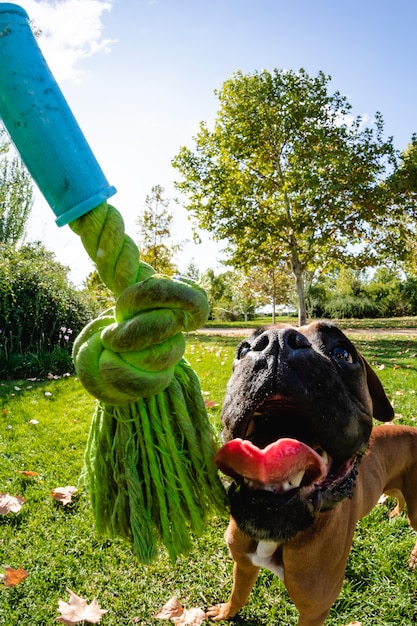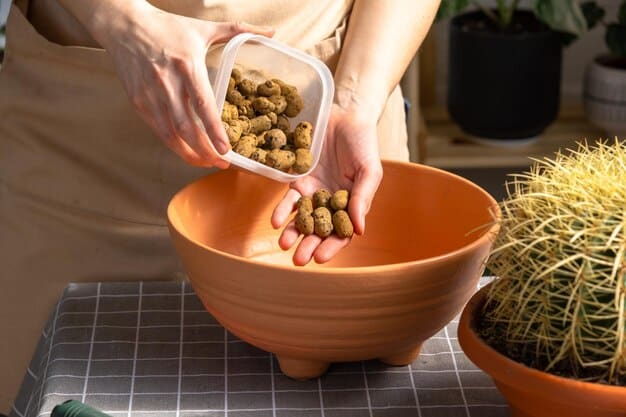Sustainable Pet Care: Eco-Friendly Tips for Pet Owners

Sustainable pet care involves making eco-conscious choices in your pet’s life, from food and toys to waste disposal, reducing their environmental impact and promoting a healthier planet.
Embracing sustainable pet care is more than a trend; it’s a commitment to reducing your furry friend’s paw print on our planet, ensuring a greener future for all. By adopting some eco-friendly practices, you can minimize your pet’s environmental impact while providing them a healthy and happy life.
Understanding Sustainable Pet Ownership
Sustainable pet ownership revolves around making eco-conscious choices to minimize your pet’s impact on the environment. It involves considering the environmental and social impact of the products you buy, the food you feed, and the waste your pet generates.
This approach not only benefits the planet but can also improve your pet’s health and well-being by promoting natural and less processed products.
What Does It Mean to Be a Sustainable Pet Owner?
Being a sustainable pet owner means being mindful of the resources consumed and waste produced by your pet.
- Choosing eco-friendly products: Opting for toys, beds, and accessories made from recycled, upcycled, or sustainable materials.
- Feeding sustainable food: Selecting pet food made with responsibly sourced ingredients and sustainable packaging.
- Proper waste disposal: Using biodegradable waste bags and composting pet waste where appropriate.
These actions collectively reduce the carbon footprint associated with pet ownership.

Benefits of Sustainable Choices
Adopting sustainable practices offers various benefits, both for the planet and your pet.
- Reduced environmental impact: Lowering your pet’s carbon footprint.
- Improved pet health: Natural and less processed products can lead to better health.
- Cost savings: Some sustainable options, like DIY toys and homemade treats, can be more economical.
Ultimately, sustainable pet ownership contributes to a healthier planet and a happier pet.
In conclusion, opting for sustainability in pet care is a forward-thinking approach, enhancing the well-being of both your pet and the environment.
Choosing Eco-Friendly Pet Food
Selecting the right food is crucial for your pet’s health and the planet’s well-being. Consider the sourcing of ingredients, packaging, and the overall environmental impact of the food you choose.
Look for brands that prioritize sustainability in their production practices.
Deciphering Pet Food Labels
Understanding pet food labels is key to making informed decisions. Here’s what to look for:
- Organic ingredients: Food made with organically grown ingredients reduces exposure to pesticides and supports sustainable farming practices.
- Sustainable protein sources: Look for food that uses sustainably sourced fish or insect-based proteins.
- Minimal processing: Choose food with whole ingredients and minimal additives or fillers.
Carefully reading labels ensures you’re giving your pet nutritious and environmentally friendly food.
Sustainable Protein Options
The protein source in pet food significantly impacts its sustainability.
- Insect-based protein: Insects require less land, water, and feed than traditional livestock, making them a sustainable alternative.
- Sustainably sourced fish: Look for fish certified by organizations like the Marine Stewardship Council (MSC).
- Plant-based protein: Incorporating plant-based proteins like legumes and grains can reduce reliance on animal products.
Opting for these alternatives lowers the environmental impact of your pet’s diet.
In summary, choosing food with sustainable practices and ingredients is fundamental to responsible pet ownership, aligning your pet’s dietary needs with environmental consciousness.
Eco-Friendly Toys and Accessories
Pet toys and accessories often end up in landfills, contributing to pollution. Choosing eco-friendly alternatives can significantly reduce this impact.
Opt for products made from sustainable, recycled, or biodegradable materials to minimize waste.
Materials to Look For
When shopping for pet toys and accessories, consider the following materials:
- Recycled plastic: Toys made from recycled plastic reduce waste and decrease the demand for new plastic production.
- Hemp: A strong, durable, and sustainable fiber that’s perfect for toys and collars.
- Organic cotton: Free from pesticides and chemicals, making it a safe and eco-friendly option for bedding and clothing.
These materials offer a more sustainable alternative to conventional pet products.
DIY Pet Toys
Making your own pet toys is a great way to reduce waste and save money.
For example, old t-shirts can be braided into a durable tug toy, while cardboard boxes can be transformed into a fun playhouse for cats.
Repurposing household items not only reduces waste but also provides your pet with unique and engaging toys.

In essence, eco-friendly toys and accessories are vital to reducing your pet’s environmental impact, supporting ethical consumption and promoting environmental responsibility.
Sustainable Waste Management
Proper waste management is a critical aspect of sustainable pet care. Dealing with pet waste responsibly helps reduce pollution and protect public health.
Using biodegradable bags and composting pet waste are effective ways to minimize environmental impact.
Biodegradable Waste Bags
Traditional plastic pet waste bags can take hundreds of years to decompose. Biodegradable bags offer a more environmentally friendly alternative.
- Look for bags certified as biodegradable or compostable.
- Ensure the bags are made from plant-based materials.
- Dispose of the bags properly in designated bins.
Switching to biodegradable bags significantly reduces plastic waste.
Composting Pet Waste
Composting pet waste can be a sustainable solution for disposing of dog poop. However, it’s essential to follow proper guidelines to ensure it’s done safely.
- Use a separate compost bin specifically for pet waste.
- Add carbon-rich materials like leaves and sawdust to aid decomposition.
- Do not use the compost on edible plants.
When done correctly, composting pet waste reduces landfill waste and creates valuable soil amendments for non-edible plants.
In short, sustainable waste management practices, such as utilizing biodegradable bags and composting, are crucial steps toward responsible pet ownership, minimizing environmental harm and promoting cleaner communities.
Water and Energy Conservation
Conserving water and energy can significantly reduce your pet’s environmental footprint. Simple changes in your pet care routine can make a big difference.
From grooming to cleaning, there are many opportunities to conserve resources.
Efficient Grooming Practices
Grooming can consume a significant amount of water and energy. Here are some ways to make it more efficient:
- Use water-saving nozzles on your pet’s showerhead.
- Opt for dry shampoo or waterless grooming products.
- Brush your pet regularly to reduce the need for frequent baths.
These practices not only save water but also reduce the energy needed to heat it.
Energy-Saving Tips
Here are some energy-saving tips for pet owners:
- Use energy-efficient pet products like heated beds and automatic feeders.
- Turn off lights in areas your pet frequents when not in use.
- Unplug electronic pet products when not charging.
By implementing these practices, you can reduce your energy consumption and lower your carbon footprint.
In conclusion, implementing water and energy conservation methods in your pet’s care is essential for reducing consumption and environmental impact, promoting sustainable practices within pet ownership.
Supporting Eco-Conscious Pet Businesses
Supporting businesses that share your commitment to sustainability is a powerful way to promote eco-friendly practices in the pet industry.
Look for businesses that prioritize ethical sourcing, sustainable production, and eco-friendly packaging.
Finding Sustainable Brands
Researching and supporting sustainable brands can drive positive change.
- Look for certifications like B Corp, Fair Trade, or USDA Organic.
- Read reviews and testimonials to assess the company’s sustainability practices.
- Support local businesses that prioritize sustainability.
By supporting these brands, you encourage the growth of the sustainable pet industry.
Encouraging Ethical Practices
You can also encourage businesses to adopt more sustainable practices by:
- Providing feedback on their products and packaging.
- Sharing information about sustainable alternatives.
- Supporting businesses that actively engage in environmental initiatives.
Your voice as a consumer can influence businesses to prioritize sustainability.
Ultimately, supporting eco-conscious pet businesses is essential to promoting sustainability within the industry, motivating companies to adopt ethical practices and contribute towards a more environmentally responsible industry.
| Key Point | Brief Description |
|---|---|
| 🌱 Eco-Friendly Food | Choose food with sustainable protein and minimal processing. |
| 🧸 Sustainable Toys | Opt for toys made from recycled or natural materials. |
| 🗑️ Waste Management | Use biodegradable bags and consider composting pet waste. |
| 💧 Water Conservation | Employ efficient grooming and water-saving techniques. |
Frequently Asked Questions
▼
Sustainable pet food uses responsibly sourced ingredients, such as sustainably caught fish or insect protein, and eco-friendly packaging to minimize environmental impact.
▼
Yes, biodegradable pet waste bags break down much faster than traditional plastic bags, reducing landfill waste and environmental pollution over time.
▼
Use water-saving nozzles, opt for dry shampoo, and brush your pet regularly to reduce the frequency of full baths, thus saving water.
▼
Eco-friendly pet toys are made from recycled plastic, hemp, or organic cotton. DIY toys from repurposed household items are also excellent sustainable options.
▼
Supporting these businesses encourages ethical sourcing, sustainable production, and eco-friendly packaging, driving positive change in the pet industry.
Conclusion
Embracing sustainable pet care is a win-win for your pet and the planet. By making small changes in your purchasing habits and daily routines, you can significantly reduce your pet’s environmental impact. From choosing eco-friendly products to conserving resources, every action counts toward creating a healthier, more sustainable world for future generations and their furry friends.





